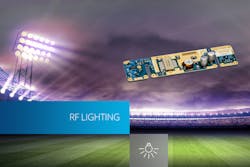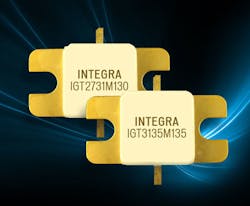High-Power Devices Have Become a High-Stakes Market
Download this article in PDF format.
Any communications system that transmits high-frequency signals into the air must do so at power levels high enough to meet the needs of the given application. For example, cell phones and base stations both must transmit signals at sufficient levels of power to enable cellular communications. And for radar and satellite-communication (satcom) systems, as well as many others, the transmission of RF/microwave signals at acceptable power levels is critical.
High-power RF/microwave technology stretches beyond data-transmission applications, though. A relatively new area of interest involves utilizing solid-state RF technology for applications such as cooking, automotive ignition, industrial heating, and more. With that in mind, suppliers of RF/microwave power devices are staying busy to meet the needs of both traditional and non-traditional applications.
Wireless Everywhere
Today, wireless communication permeates through every part of the globe. And wireless traffic can rise dramatically at certain times in one environment, particularly during major events like the Super Bowl. To put this into context, NXP Semiconductors recently published an interesting blog post, “Wireless Providers at Super Bowl LII Can’t Afford a Fumble.” The author, Jim Norling, vice president, RF cellular infrastructure at NXP, described how wireless carriers prepared for the massive amounts of voice, data, and video traffic that were expected at this year’s Super Bowl in Minneapolis.
According to the post, technicians from the major cellular carriers reinforced the Minneapolis metro area’s infrastructure, adding more small cells and strengthening both fronthaul and backhaul paths with more fiber. Verizon increased the number of remote units in its distributed antenna system (DAS) at the stadium by 50%. The carrier also added cell sites and small cells at both the Mall of America and Minneapolis-St. Paul International Airport.
T-Mobile boosted LTE capacity by 35% and added carrier aggregation. AT&T utilized LTE-Advanced, increased antennas in the stadium to 800, and deployed a DAS at 16 places in the area. Not to be outdone, Sprint built its own 800-remote DAS in the stadium, used LTE-Advanced and carrier aggregation, and mounted 200 small cells throughout Minneapolis.
What was a key ingredient in all of this activity? According to the post, RF power transistors make it all possible, as they allow the thousands of DAS remote units, small cells, and base stations to transmit signals indoors and outdoors—in any kind of weather. Without these RF power transistors, the wireless activity at an event like the Super Bowl wouldn’t be possible.
Norling also explained, “According to www.mobilesportsreport.com, mobile data record usage keeps climbing, enabled by smart stadium network DASs. We supply RF power transistors—key components for the DAS networks—keeping sports fans connected with essential coverage to call, text, and stream video anywhere within the stadiums and other venues.”
The New Realm of RF Cooking
Solid-state RF technology is now making inroads into RF energy applications, with cooking being one specific area of interest. For instance, NXP is also developing technology to cook and defrost food.
Earlier this year, the company announced its smart defrost solution. “Our smart defrost solution uses solid-state RF energy to rapidly and automatically thaw a wide range of frozen foods to an even temperature and with minimal moisture loss,” said Pierre Piel, senior director and general manager for multi-market RF power at NXP.” The smart defrost solution is based on NXP’s laterally diffused metal oxide semiconductor (LDMOS) technology.
Piel added, “Once your food is defrosted, you can cook it using solid-state RF energy from NXP, too. Closed-loop RF heating systems are influencing the latest automated and connected smart-appliance market, using RF energy for even heating, consistency, and adaptability. NXP is enabling original equipment manufacturers (OEMs) to differentiate smart kitchen appliances with unique and high-quality cooking and defrost solutions.”
Another company heavily invested in solid-state RF cooking is MACOM, with the company touting its gallium-nitride-on-silicon (GaN-on-Si) technology for such applications. MACOM recently published the blot post, “RF Energy in Daily Life Part 5: GaN for Baking.” The post stated, “Consumers will benefit from solid-state RF energy in significant ways centric to system reliability, food processing speed, and throughput. The evolution of the solid-state microwave oven is expected to result in a device that is capable of cost-effective baking with unprecedented efficiency, ensuring a cake rises and bakes evenly, and cupcakes on the outer rim of the pan bake as evenly as those in the center.”
More RF Energy Applications
Cooking isn’t the only application for RF energy. As mentioned earlier, automotive ignition and industrial heating are among the other application possibilities. At the forefront of it all is the RF Energy Alliance (RFEA), which is a non-profit technical association comprised of companies “dedicated to realizing the potential of solid-state RF energy as a clean, highly efficient, and controllable heat and power source.” Member companies include both NXP and MACOM.
Another RFEA member company to take note of is Ampleon. The firm recently introduced the BLF0910H9LS600, which is a 600-W LDMOS power transistor for RF energy applications. The device operates in the 915-MHz band.
1. This 200-W PA module from Ampleon is intended for applications like plasma lighting, industrial heating, and cooking and defrosting.
Another new device developed by Ampleon is the BPC10M6X2S200—a 200-W LDMOS power-amplifier (PA) module (Fig. 1). Operating at 423 to 443 MHz, the amplifier is suitable for applications like plasma lighting, industrial heating, and cooking and defrosting.
Powering Radar Applications
A discussion of high-power RF devices wouldn’t seem complete without mentioning radar applications. How have the requirements for high-power radar applications changed in recent years?
“There are two changes that I see,” explains John Walker, senior engineer at Integra Technologies. “Firstly, with the advent of GaN, it is now feasible to generate much higher power than was previously possible using solid-state at S-band and above. Consequently, there is much interest in developing solid-state alternatives to traveling-wave tubes (TWTs) at S-band and above. The second trend is the move toward much longer pulse length and higher duty cycle solid-state amplifiers in radar systems for longer range detection.”
2. Shown are two GaN-on-SiC transistors developed by Integra for S-band radar applications.
Integra recently announced several new products, such as the IGT2731M130 and IGT3135M135 GaN-on-silicon-carbide (GaN-on-SiC) transistors for S-band radar applications (Fig. 2). The IGT2731M130, which covers a frequency range of 2.7 to 3.1 GHz, delivers a minimum of 130 W of peak output power. The IGT3135M135 covers a frequency range of 3.1 to 3.5 GHz while delivering as much as 135 W of peak output power.
The landscape for RF power devices is clearly vast, as wireless communications, radar systems, new RF energy applications, and more are prompting suppliers to raise the bar to meet these tougher requirements. It will be interesting to see how RF energy applications—which are still in the early stages—unfold over time as suppliers develop the products to make these applications mainstream.



